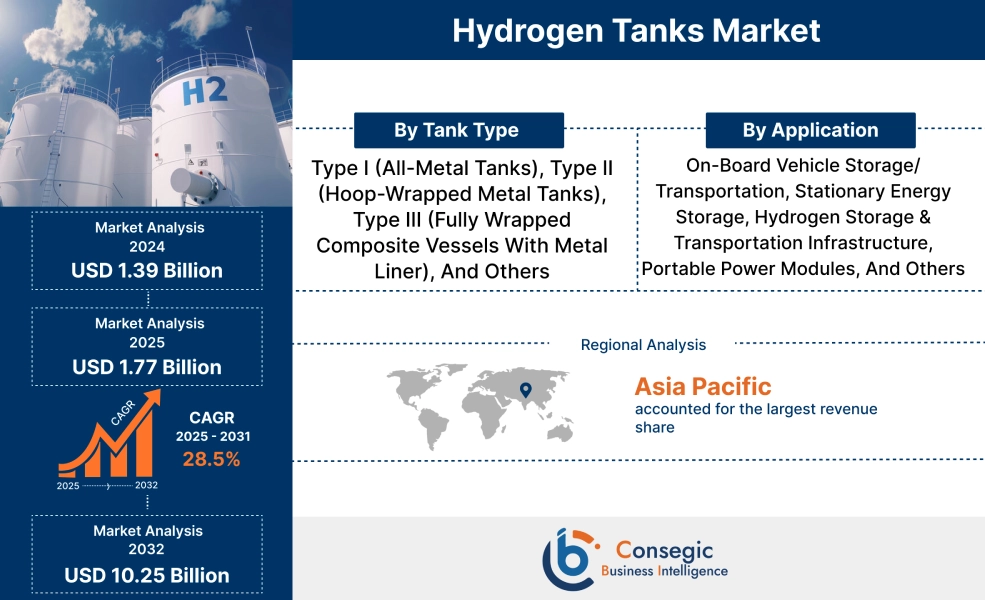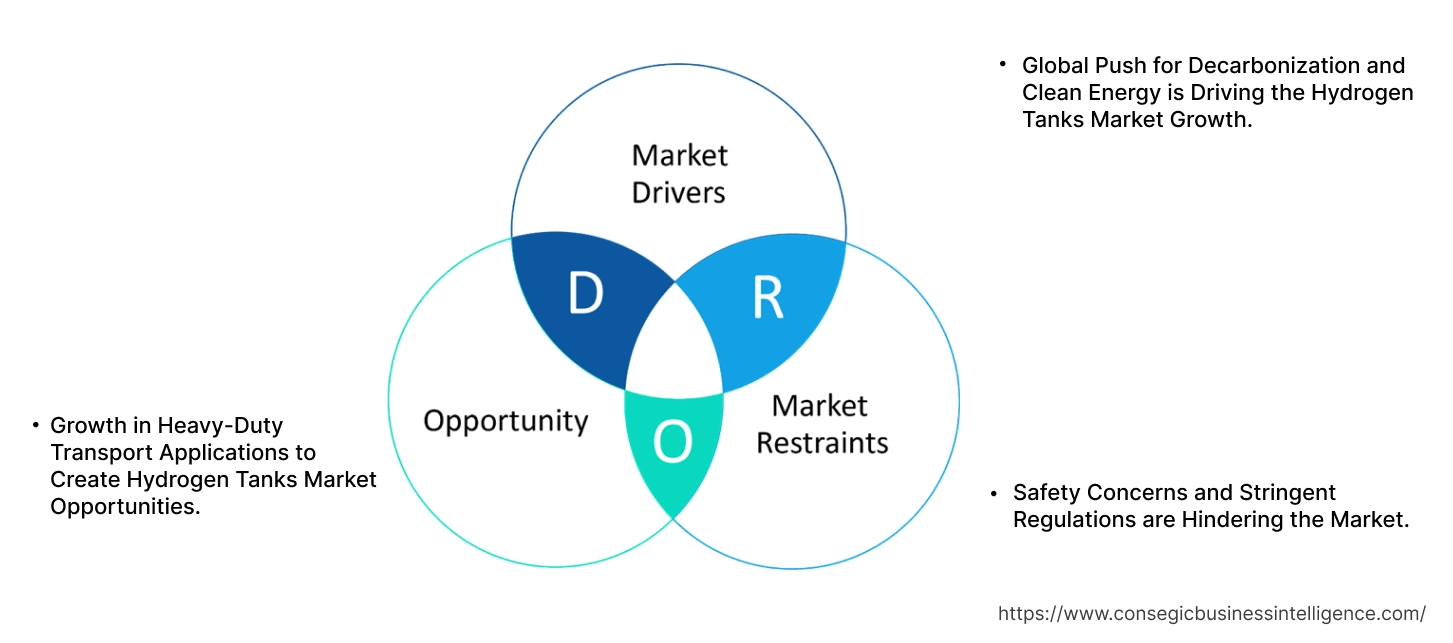Hydrogen Tanks Market Size:
The Hydrogen Tanks Market size is growing with a CAGR of 28.5% during the forecast period (2025-2032), and the market is projected to be valued at USD 10.25 Billion by 2032 from USD 1.39 Billion in 2024. Additionally, the market value for 2025 is attributed to USD 1.77 Billion.
Hydrogen Tanks Market Scope & Overview:
Hydrogen tanks are important for the growing hydrogen economy, providing the means to store and transport this clean energy carrier. As the globe is focusing on decarbonization, the demand for efficient, safe, and cost-effective hydrogen storage is soaring across various applications and is supporting industrial processes. These specialized pressure vessels are important for containing hydrogen gas or liquid under extreme conditions, with their design and materials directly impacting capacity, weight, safety, and cost. The market is primarily driven by the global need for decarbonization, strong government support for hydrogen initiatives, and continuous technological improvements. Innovations in materials and manufacturing such as the rise in the green hydrogen projects, and the exploration of new applications in heavy-duty transport and industrial sectors are contributing to market growth.
Hydrogen Tanks Market Dynamics - (DRO) :
Key Drivers:
Global Push for Decarbonization and Clean Energy is Driving the Hydrogen Tanks Market Growth.
The rise in industries increasingly focusing on hydrogen as a clean energy carrier, particularly green hydrogen that is produced from renewable sources lead to the high demand for efficient and safe storage solutions. This rise is driven by factors such as robust government support and incentives for hydrogen infrastructure, and continuous technological advancements in tank materials and designs.
- For instance, according to World Economic Forum, the clean power surpassed the global generation of electricity by more than 35% in 2024.
Hence, due to the aforementioned factors, the global push for decarbonization and clean energy is driving the hydrogen tanks market growth.
Key Restraints:
Safety Concerns and Stringent Regulations are Hindering the Market.
Hydrogen's wide explosive range, and difficulty in detection pose considerable risks, leading to the requirement of strict safety protocols. Similarly, governments have imposed complex regulations on the design, manufacturing, testing, and transportation of these tanks. Adhering to these demanding standards require specialized materials and rigorous testing, which increases production costs and hinders the achievement of economies of scale. Additionally, the technical barriers of safely containing such as volatile gas along with the regulatory aspects and associated expenses, are contributing to hindrances in the hydrogen tanks market expansion.
Future Opportunities :
Growth in Heavy-Duty Transport Applications to Create Hydrogen Tanks Market Opportunities.
Sectors such as public bus fleets, and emerging marine and rail uses are increasingly recognizing the advantages of hydrogen fuel cell electric vehicles (FCEVs) over battery-electric alternatives. These include the benefits of longer range and rapid refueling times, that are important for minimizing downtime in commercial operations along with the ability to maintain higher payload capacities due to the lighter weight of hydrogen storage systems. With the focus on decarbonization along with the supportive government initiatives and ongoing technological advancements in lightweight, high-pressure composite tanks, heavy-duty transport is expected to create potential in the futuristic scenarios.
- For instance, according to IEA, the sale of medium and heavy-duty trucks that were electrically based grew in 2024, surpassing 90,000 across the globe.
Thus, as per analysis, growth in heavy-duty transport applications is expected to create hydrogen tanks market opportunities.
Hydrogen Tanks Market Segmental Analysis :
By Tank Type:
Based on Tank Type, the market is categorized into Type I (All-Metal Tanks), Type II (Hoop-Wrapped Metal Tanks), Type III (Fully Wrapped Composite Vessels with Metal Liner), and others.
Trends in Tank Type:
- Type I tanks are the most common choice for stationary storage applications, where weight is less of a concern.
- Type III hydrogen tanks are experiencing robust growth, due to the increasing adoption of hydrogen fuel cell technology trends.
The Type I segment accounted for the largest hydrogen tanks market share of 46.29% in 2024.
- Type I hydrogen tanks are designed entirely from materials like steel or aluminum, showcasing dominance in the market. This prominence is due to the factors such as straightforward manufacturing process, inherent durability, and lower production costs.
- They are the suitable solution for stationary storage applications, including bulk hydrogen storage for industrial operations, power generation facilities, and hydrogen fueling stations.
- For instance, according to Fuel Cells Works, more than 120 new hydrogen refueling stations opened in 2024 across the globe.
- Thus, as per the market analysis, the type I segment is dominating the hydrogen tanks market expansion.
The Type III segment is expected to grow at the fastest CAGR over the forecast period.
- Type III tanks offer a balance between weight, pressure capacity, and cost. It comprises of a metal liner wrapped in composites and offers significant weight savings and high-pressure capabilities as opposed to type I and II tanks.
- These features make them suitable for the rapidly expanding medium and heavy-duty vehicle markets, such as buses and trucks, where the balance of performance and economic viability is crucial.
- Furthermore, their durability and high-pressure handling makes them a preferred choice for fixed storage in hydrogen refueling stations.
- Thus, as per the market analysis, the type III segment is dominating the hydrogen tanks market expansion.
By Application:
Based on the Application, the market is categorized into on-board vehicle storage/transportation, stationary energy storage, hydrogen storage & transportation infrastructure, portable power modules, and others.
Trends in the Application
- The rise in development and adoption of hydrogen fuel cell electric vehicles, particularly in heavy-duty transport, is rising trend.
- The preference for stationary storage includes bulk hydrogen storage for industrial use, power generation, and grid-scale energy storage systems is a trend positively impacting the market.
The stationary energy storage segment accounted for the largest market share in 2024.
- The stationary energy storage segment is dominating due to the utilization of the use of hydrogen in industrial processes, where it is used as a feedstock for chemical production, petroleum refining, and steel manufacturing.
- For large volumes, cost-effective type I (all-metal) tanks are suitable for bulk storage, as weight and portability are not critical concerns.
- Furthermore, hydrogen is increasingly vital for grid-scale energy storage, enabling the integration of renewable energy sources such as solar and wind by storing surplus power for later use, thereby enhancing grid stability and reliability.
- For instance, according to the American Clean Power Association (ACP), the grid-scale energy storage deployed 2,773 MW and 9,982 MWh in second quarter of 2024 in the U.S.
- Thus, based on the market analysis, the stationary energy storage segment dominates hydrogen tanks market demand.
The on-board vehicle storage/transportation segment is expected to grow at the fastest CAGR over the forecast period.
- The on-board vehicle storage/transportation segment is driven by the increase in global shift towards decarbonizing the transportation sector, particularly in heavy-duty applications such long-haul trucks, buses, and potentially trains and ships.
- Hydrogen Fuel Cell Electric Vehicles provide advantages including longer ranges and significantly faster refueling times compared to battery electric alternatives.
- The increasing development of lightweight, high-pressure composite tanks, combined with substantial government support, incentives, and investments in hydrogen refueling infrastructure worldwide are directly contributing to market growth.
- Thus, as per the hydrogen tanks market analysis, the on-board vehicle storage/transportation segment is the fastest growing segment in the hydrogen tanks market demand.
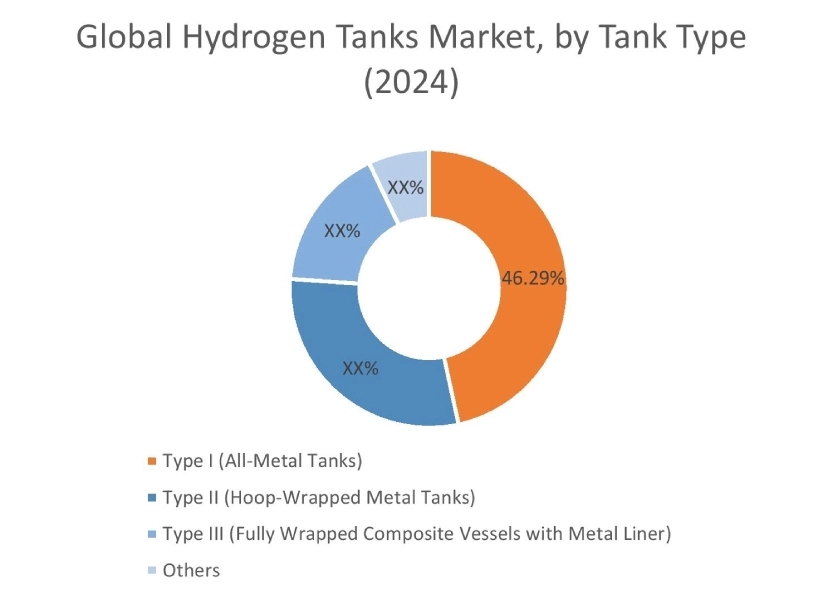
Regional Analysis:
The regional segment includes North America, Europe, Asia Pacific, the Middle East and Africa, and Latin America.
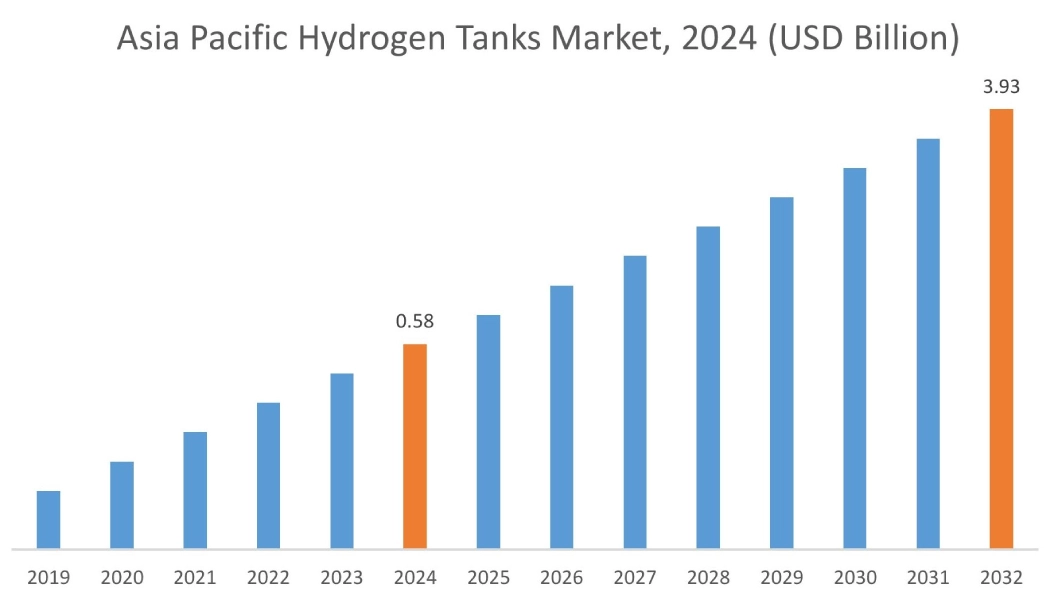
In 2024, Asia Pacific accounted for the highest hydrogen tanks market share at 42.13% and was valued at USD 0.58 Billion and is expected to reach USD 3.93 Billion in 2032. In Asia Pacific, China accounted for a market share of 39.74% during the base year of 2024. The Asia Pacific region leads the charge with national hydrogen strategies in countries like Japan, South Korea, China, Australia, and India, all focusing for aggressive targets in hydrogen production, consumption, and infrastructure. This is leading to an increase in demand for both stationary hydrogen storage tanks and lightweight, high-pressure composite tanks important for the market of hydrogen fuel cell electric vehicles in heavy-duty transport.
- For instance, according to the National Development and Reform Commission, the number of FCEVs reached more than 45,000 units in 2025 and is expected for full commercialization by 2035 in China.
Therefore, the above-mentioned factors are contributing to the region’s dominance in the market trend.
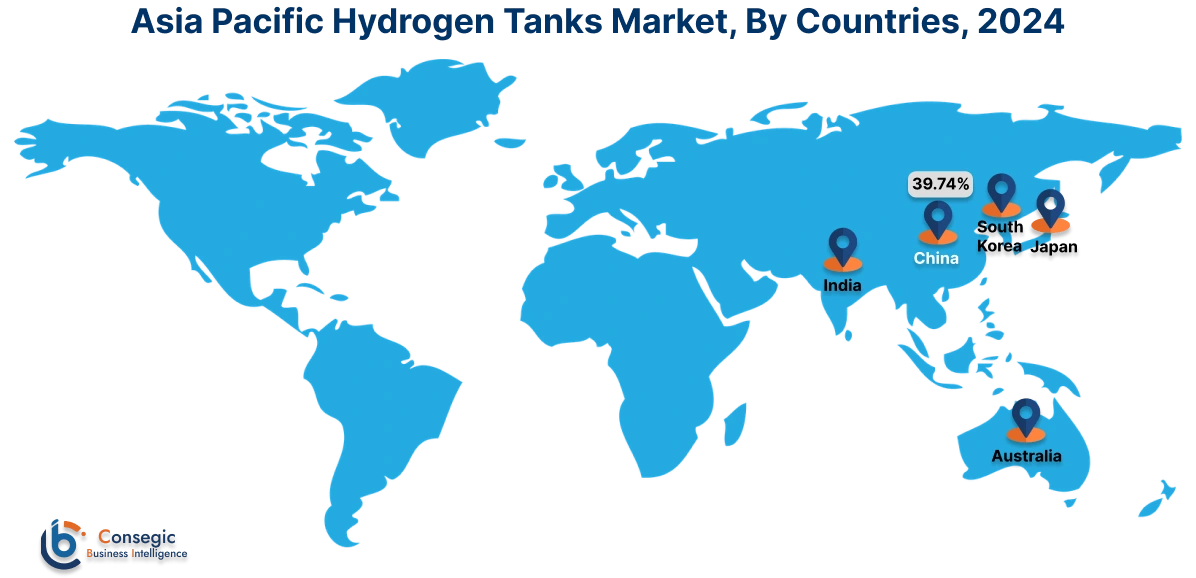
In North America, the hydrogen tanks market is experiencing the fastest growth with a CAGR of 31.0% over the forecast period. The increase in adoption of fuel cell electric vehicles is a primary driver for the North American hydrogen tanks market trend, especially for advanced composite varieties. This trend is driven by the focus on decarbonization of heavy-duty transport, where FCEVs offer advantages such as extended range, rapid refueling, and higher payload capacity that are important for commercial operations. In addition to this, robust government support through initiatives such as the U.S.'s hydrogen hubs and the Inflation Reduction Act, alongside California's leadership in refueling infrastructure, is creating a suitable environment for FCEV deployment. These aforementioned factors are boosting the requirement for hydrogen storage solutions in the region.
Increased investment in green hydrogen projects act as a significant driver for the European hydrogen tanks market analysis. Europe's decarbonization goals translate into substantial funding commitments. These investments are targeting the large-scale production of green hydrogen, which in turn necessitates extensive storage infrastructure, ranging from large-scale stationary tanks for industrial decarbonization to lightweight composite tanks important for the growing fleet of fuel cell electric trucks and buses. These factors are contributing to regional analysis.
The Middle East and Africa (MEA) regions are creating potential for hydrogen tanks that are growing focus on heavy-duty transport applications. Domestic decarbonization efforts are increasingly targeting sectors such as trucking and public transit. Countries including Saudi Arabia and the UAE are implementing pilot projects with hydrogen-powered buses, demonstrating a commitment to sustainable transport. This growing preference along with the strategic investments in hydrogen production and nascent infrastructure development contributes to MEA's heavy-duty transport sector as a key driver for the adoption of advanced hydrogen tanks in the coming years.
The increasing usage of hydrogen as a shipping fuel in Latin America represents a significant opportunity for the region's hydrogen tanks market trend. By utilizing its abundant renewable energy resources, Latin America is poised to become a major producer of green hydrogen, fueling both domestic and international maritime vessels. This potential is due to the global shipping industry's need to decarbonize, creating future demand for specialized onboard hydrogen tanks in the region.
Top Key Players and Market Share Insights:
The Global Hydrogen Tanks Market is highly competitive with major players providing products to the national and international markets. Key players are adopting several strategies in research and development (R&D) and product innovation to hold a strong position in the global Hydrogen Tanks market. Key players in the Hydrogen Tanks industry include
- Worthington Enterprises (US)
- Luxfer Group (England)
- Composite Advanced Technologies
- LLC (US)
- NPROXX (Germany)
- Tenaris (Luxembourg)
- Hexagon Purus (Norway)
- Quantum Fuel Systems LLC (US)
- Faber Industrie S.p.A. (Italy)
- Everest Kanto Cylinder Ltd. (India)
- Beining Tianhai Industry Co. Ltd. (China)
Hydrogen Tanks Market Report Insights :
| Report Attributes | Report Details |
| Study Timeline | 2019-2032 |
| Market Size in 2032 | USD 10.25 Billion |
| CAGR (2025-2032) | 28.5% |
| By Tank Type |
|
| By Application |
|
| By Region |
|
| Key Players |
|
| North America | U.S. Canada Mexico |
| Europe | U.K. Germany France Spain Italy Russia Benelux Rest of Europe |
| APAC | China South Korea Japan India Australia ASEAN Rest of Asia-Pacific |
| Middle East and Africa | GCC Turkey South Africa Rest of MEA |
| LATAM | Brazil Argentina Chile Rest of LATAM |
| Report Coverage |
|
Key Questions Answered in the Report
How big is the Hydrogen Tanks market? +
In 2024, the Hydrogen Tanks market is USD 1.39 Billion.
Which is the fastest-growing region in the Hydrogen Tanks market? +
North America is the fastest-growing region in the Hydrogen Tanks market.
What specific segmentation details are covered in the Hydrogen Tanks market? +
By Tank Type and Application segmentation details are covered in the Hydrogen Tanks market.
Who are the major players in the Hydrogen Tanks market? +
Worthington Enterprises (US), Luxfer Group (England), Hexagon Purus (Norway), Quantum Fuel Systems LLC (US), Faber Industrie S.p.A. (Italy), Everest Kanto Cylinder Ltd. (India), Beining Tianhai Industry Co. Ltd. (China) are some of the major players in the market.
